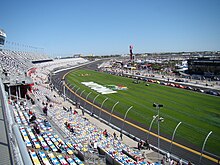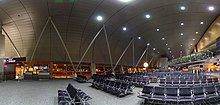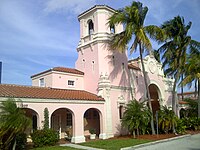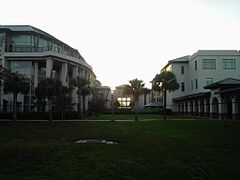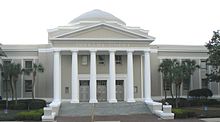Further information: Transportation in South Florida
- Miami: Miami's public transportation is served by Miami-Dade Transit that runs Metrorail, a heavy rail rapid transit system, Metromover, a people mover train system in Downtown Miami, and Metrobus, Miami's bus system. Metrorail runs throughout Miami-Dade County and has two lines and 23 stations connecting to Downtown Miami's Metromover and Tri-Rail. Metromover has three lines and 21 stations throughout Downtown Miami. Outside of Miami-Dade County, public transit in the Miami metropolitan area is served by Broward County Transit and Palm Tran; intercounty commuter rail service is provided by Tri-Rail, with 18 stations including the region's three international airports.
- Orlando: Orlando is served by the SunRail commuter train, which runs on a 32 miles (51 km) (61 miles (98 km) when complete) line including four stops in downtown. Lynx bus serves the greater Orlando area in Orange, Seminole, and Osceola counties.
- Tampa: Tampa and its surrounding area use the Hillsborough Area Regional Transit Authority system ("HART"). In addition, downtown Tampa has continuous trolley services in the form of a heritage trolley powered by Tampa Electric Company. Pinellas County and St. Petersburg provide similar services through the Pinellas Suncoast Transit Authority or "PSTA". The beaches of Pinellas County also have a continuous trolley bus. Downtown St. Petersburg has a trolley system.
- Jacksonville: Jacksonville is served by the Jacksonville Skyway, an automated people mover monorail connecting the Florida State College downtown campus, the Northbank central business district, Convention Center, and Southbank locations. The system includes 8 stops connected by two lines. JTA bus has 180 vehicles with 56 lines.
| Rank | City | Weekday passenger ridership |
Population served |
% of population on transit |
Modes of transit |
|---|---|---|---|---|---|
| 1 | Miami | 367,000[232] | 2,554,776 | 14.4% | Tri-Rail, Metrorail, Metromover & Metrobus |
| 2 | Fort Lauderdale | 147,718[233] | 1,748,066 | 8.5% | Tri-Rail (commuter rail) & BCT bus |
| 3 | Orlando | 97,000[234] | 2,134,411 | 4.4% | Lynx bus & Sunrail |
| 4 | Gainesville | 50,500[234] | 125,326 | 40.3% | RTS bus |
| 5 | Tampa | 50,400[234] | 1,229,226 | 4.1% | HART bus & TECO Line Streetcar |
| 6 | West Palm Beach | 45,100[235] | 1,320,134 | 3.4% | Tri-Rail (commuter rail) & Palm Tran (bus) |
| 7 | St. Petersburg | 42,500[236] | 916,542 | 4.6% | PSTA bus |
| 8 | Jacksonville | 41,500[234] | 821,784 | 5.0% | JTA bus & Skyway (people mover) |
| 9 | Tallahassee | 22,400[234] | 181,376 | 12.4% | StarMetro bus |
Sports
Main article: Sports in Florida
Daytona International Speedway is home to various auto racing events
About half of all Major League Baseball teams conduct spring training in the state, with teams informally organized into the "Grapefruit League". Throughout MLB history, other teams have held spring training in Florida.
NASCAR (headquartered in Daytona Beach) begins all three of its major auto racing series in Florida at Daytona International Speedway in February, featuring the Daytona 500, and ends all three Series in November at Homestead-Miami Speedway. Daytona also has the Coke Zero 400 NASCAR race weekend around Independence Day in July. The 24 Hours of Daytona is one of the world's most prestigious endurance auto races. The Grand Prix of St. Petersburg and Grand Prix of Miami have held IndyCar races as well.
The PGA of America is headquartered in Palm Beach Gardens, the PGA Tour is headquartered in Ponte Vedra Beach, and the LPGA is headquartered in Daytona Beach. The Players Championship, WGC-Cadillac Championship, Arnold Palmer Invitational, Honda Classic and Valspar Championship are PGA Tour rounds.
The Miami Masters is an ATP World Tour Masters 1000 and WTA Premier tennis event, whereas the Delray Beach International Tennis Championships is a ATP World Tour 250 event.
Minor league baseball, football, basketball, ice hockey, soccer and indoor football teams are based in Florida. Three of the Arena Football League's teams are in Florida.
Florida's universities have a number of collegiate sport programs, especially the Florida State Seminoles and Miami Hurricanes of the Atlantic Coast Conference and the Florida Gators of the Southeastern Conference.
| Team | League | Venue | Location | Championships |
|---|---|---|---|---|
| Miami Dolphins | National Football League | Sun Life Stadium | Miami Gardens | 2 (1972, 1973) |
| Miami Heat | National Basketball Association | American Airlines Arena | Miami | 3 (2006, 2012, 2013) |
| Miami Marlins | Major League Baseball | Marlins Park | Miami | 2 (1997, 2003) |
| Florida Panthers | National Hockey League | BB&T Center | Sunrise | 0 |
| Tampa Bay Buccaneers | National Football League | Raymond James Stadium | Tampa | 1 (2003) |
| Tampa Bay Rays | Major League Baseball | Tropicana Field | St. Petersburg | 0 |
| Tampa Bay Lightning | National Hockey League | Amalie Arena | Tampa | 1 (2004) |
| Orlando Magic | National Basketball Association | Amway Center | Orlando | 0 |
| Orlando City SC | Major League Soccer | Orlando City Stadium | Orlando | 0 |
| Jacksonville Jaguars | National Football League | EverBank Field | Jacksonville | 0 |
Sister states
| Sister jurisdiction | Country | Year[238] |
|---|---|---|
| Languedoc-Roussillon | 1989 | |
| Taiwan Province | 1992 | |
| Wakayama Prefecture | 1995 | |
| Western Cape | 1995 | |
| Nueva Esparta | 1999 | |
| Kyonggi | 2000 |
See also
- Outline of Florida – organized list of topics about Florida
- Index of Florida-related articles
- Ecology of Florida
- List of counties in Florida
- List of people from Florida
- List of places in Florida
- List of sister cities in Florida
- Music of Florida
- List of National Register of Historic Places in Florida
- Timeline of Florida History
